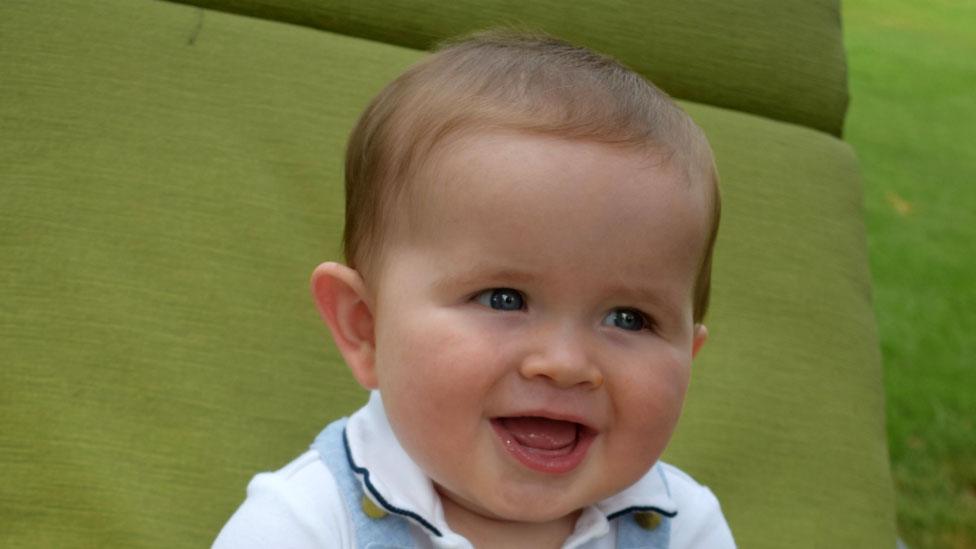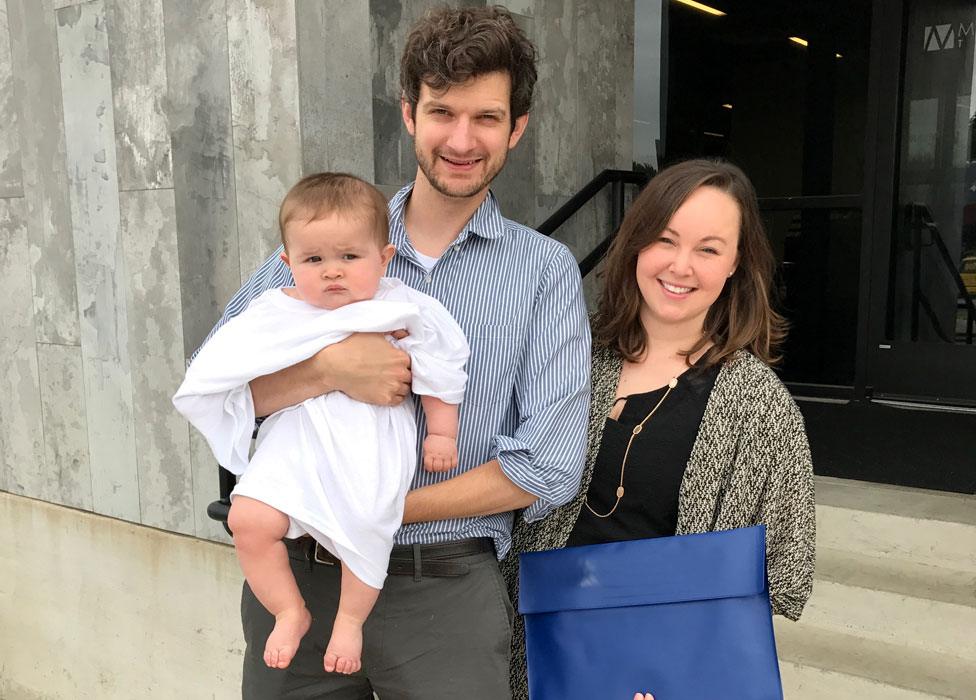Is my baby too big, or just big?
- Published

When Tom and Elizabeth Flight were told their seven-month-old baby Arlo was in the 90th percentile for height, the 97th percentile for weight and the 99th for head circumference, they began to worry. How big can a baby get and still be considered normal, asks Jordan Dunbar.
"I'm worried he's one of the biggest babies in America," says his father Tom, a 6' 3" (191cm) Brit who moved to Texas to marry Elizabeth.
At birth, Arlo weighed seven-and-a-half pounds, but he grew rapidly over the next six months on a diet of breast milk alone.
For the last month he has been getting formula milk as well from time to time, and he's now more than three times his birth weight - 24lb (11kg). And 30in (76cm) tall.
The percentile figures come from a growth chart produced by America's Centers for Disease Control (CDC). Every five years the CDC measures hundreds of thousands of babies, children and young adults up to the age of 20, and the resulting charts allow doctors to assess what percentage of children of a given age group are taller or heavier than the patient in front of them.
"If you line up 100 babies of Arlo's age, from the shortest to the longest. Arlo would be 97," says Dr Joe Hagan from the American Academy of Pediatrics, explaining what it means to be in the 97th percentile.
"If you count head circumference he'd be 99."

So only one in 100 American babies aged seven months has a bigger head circumference than Arlo. Does this matter?
Hagan is completely relaxed about it. Head circumference helps doctors to judge whether a baby's brain is developing normally, he says, but the key thing is that the head is in proportion with the rest of the body, and Arlo's is.
"I would expect at Arlo's weight and height that his head circumference would be in the 99th percentile," says Hagan.

International comparisons
The charts produced by the CDC in the US are based on the measurements of real-life Americans. But over time, American children have been getting bigger, and an increasing number of American children are overweight.
By contrast the World Health Organization (WHO) has attempted to chart "optimal growth" for a child.
To do this, it measured growing children in six countries: Brazil, Ghana, India, Norway, Oman and the US. But not just any children. They had to be breast-fed from birth, and vaccinated early in life. Babies whose mothers had smoked during pregnancy were not counted.
Dr Mercedes De Onis, who helped to gather the data, says the WHO's work shows babies develop at a similar rate all over the world, "provided they are given proper care".
The WHO charts "describe healthy growth in optimal conditions and are therefore growth standards rather than growth references", says US paediatrician Joe Hagan.
He points out that in the US the CDC is now recommending that the WHO charts should be taken as the standard for children in the US between zero and two years old.

What about Arlo's weight? Is that a problem?
Once again, Hagan draws attention to Arlo's height. The key thing to look at is his body mass index, or BMI - his weight in relation to his height.
"So here's a guy who's tall, he's long. And longer children weigh more," says Hagan.
"Arlo probably has a BMI that is in the mid-80s to low 90s which would be considered overweight."
Overweight, but not obese. What's more, Hagan expects that as Arlo makes the transition from milk to solids, and starts moving more, he will even out a little.

So is there any cause for concern?
"No, not like this. Because I'm looking at Arlo's dad who's tall and Arlo's mom, who's probably tall, and I'm thinking: 'Gee, this is OK growth for Arlo.'"
Arlo is one of the biggest babies of his age in the US, and as American babies are bigger than the world average, it's also true to say he is one of the biggest in the world.
But it seems that's fine.

Find out more
More or Less is broadcast on BBC Radio 4 and the World Service
Download the More or Less podcast
More stories from More or Less

"I spend a lot of my time in my day-to-day work as a paediatrician telling parents you really don't need to worry about this and about that," Hagan says.
Parents often compare the size of their child to others, he says, and very often it's his task to reassure them that even if their child is bigger or smaller, there is a "wide range of normal".
Join the conversation - find us on Facebook, external, Instagram, external, Snapchat , externaland Twitter, external.